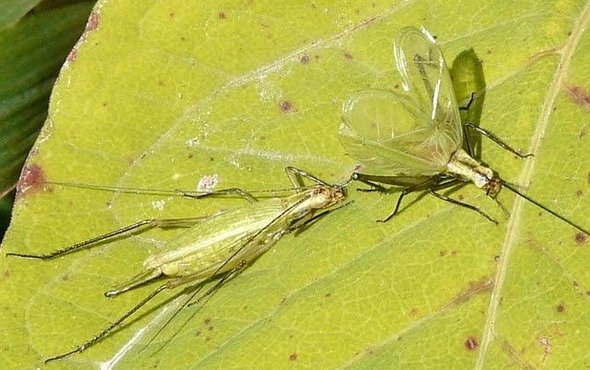(单词翻译:单击)
听力文本
This is Scientific American — 60-Second Science. I'm Jason G. Goldman.
Not too long ago we thought that only humans could make and use tools. Then Jane Goodall watched a chimpanzee called David take a small twig, snap the leaves off, stick it into a termite mound, and lick the insects off the stick. Seems some animals also made and used tools.
That observation was in 1960. Since then the club of tool users has expanded to include a wide range of primates, birds, marine mammals, and others. And now: an insect. Maybe.
Tree crickets use sound to attract mates. And they also fashion and use "baffles"—sound controllers—made of leaves to produce sound more efficiently. It's a behavior that's been known since at least 1975, but nobody ever really tried to figure out out how and why the bugs use the baffles.
"The way that tree crickets sing is to raise their wings and vibrate their wings back and forth. This causes sound to come off each surface of the wing, the front face of the wing and the back face of the wing."
University of Toronto biologist Natasha Mhatre.
But sound waves coming off the front of the wings and the sound waves coming off the back of the wings are out of phase with each other. The two sounds interfere with each other, making the call quieter.

To make a baffle, the cricket carves a small hole in the center of a leaf and sticks its body halfway through. The baffle absorbs sound coming from the back of the wings, and therefore lets the sounds coming from the front sides to come through loud and clear.
"And this prevents what we call acoustic short-circuiting, and therefore they make more sound."
But do these structures count as tools?
Mhatre weighed the behavior against the most recent definition for tool use described in the scientific literature. And based upon the requirements of that definition, it would seem that tree crickets do indeed make and use tools. The findings are in the journal Ethology.
So what does this discovery mean for the link between tool use and animal smarts?
"I don't know if I want to say it exactly this way but it actually takes tool use down a notch. Because if you see tool use in an animal, you can't immediately say the animal is smart. Even if you see optimal tool use in the animal, you can't say, well that's a really clever animal. Because actually that could be an inherited behavior."
Thanks for the minute for Scientific American — 60-Second Science. I'm Jason G. Goldman.
参考译文
这里是科学美国人——60秒科学。我是杰森·古德曼。
不久之前,我们还认为只有人类才能制造和使用工具。可是之后,珍妮·古德尔观察到一只名叫大卫的黑猩猩拿起一根小树枝,揪掉上面的树叶,将树枝插进白蚁丘里,然后舔掉树枝上的昆虫。似乎有些动物也能制造和使用工具。
这是在1960年观察到的情况。自那以后,制造和使用工具的动物不断增加,包括灵长类动物、鸟类、海洋哺乳动物等各个物种。而现在,昆虫也加入到了这一行列中。也许是这样。
树蟋用声音来吸引配偶。它们还会制作并使用“控声板”,这是由树叶制成的声音控制器,可以更有效地发出声音。这种行为至少从1975年开始就为人所知,但从没有人真正试图去弄清树蟋如何以及为何会使用这种控声板。
“树蟋的发声方式是抬起翅膀来回振动。这使翅膀的各面——前面和后面——都会发出声音。”
多伦多大学的生物学家纳塔莎·马特尔说到。
但是翅膀前面和后面发出的声波彼此不协调。这两种声音会相互干扰,使树蟋叫声变小。
为了制作控声板,树蟋会在一片树间切一个小洞,然后将半个身体穿过小洞。控声板会吸收翅膀后面发出的声音,这使来自翅膀前面的声音更加响亮和清晰。
“这可以防止所谓的‘声短路',所以它们能发出更响亮的声音。”
但这些结构算工具吗?
马特尔将树蟋的行为与科学文献对工具使用的最新定义进行了比较。基于最新定义的要求,看起来树蟋的确是在制造并使用工具。这项研究结果发表在《动物行为学》期刊上。
那对于工具使用和动物智慧之间的联系,这项发现意味着什么?
“我不知道我是否真的想这么说,但这一发现实际上降低了工具的使用。因为,如果你看到一只动物在使用工具,你不能马上就说那个动物有智慧。即使你看到该动物对工具进行了最优使用,你也不能说它非常聪明。因为实际上那可能是一种遗传行为。”
谢谢大家收听科学美国人——60秒科学。我是杰森·古德曼。
译文为可可英语翻译,未经授权请勿转载!
重点讲解
重点讲解:
1. back and forth 来回;往返;
I could see the branches of the trees moving back and forth.
我能看到树枝来回摇摆。
2. out of phase with 不同步的(地);不协调的(地);
The Skills Programme is out of phase with the rest of the curriculum.
技能课程与其他课程不协调。
3. interfere with 妨碍;冲突;抵触;
She never allows her personal feelings to interfere with her work.
她从不让她的个人感情妨碍工作。
4. even if 即使;尽管;纵然;
I only take on work that excites me, even if it means turning down lots of money.
我只做那些令我感兴趣的工作,即使这意味着要少赚很多钱。


